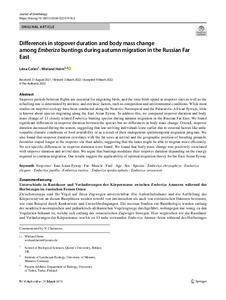Differences in stopover duration and body mass change among Emberiza buntings during autumn migration in the Russian Far East
Collet Léna; Heim Wieland
Differences in stopover duration and body mass change among Emberiza buntings during autumn migration in the Russian Far East
Collet Léna
Heim Wieland
SPRINGER HEIDELBERG
Julkaisun pysyvä osoite on:
https://urn.fi/URN:NBN:fi-fe2022081153997
https://urn.fi/URN:NBN:fi-fe2022081153997
Tiivistelmä
Stopover periods between flights are essential for migrating birds, and the time birds spend at stopover sites as well as the refuelling rate is determined by intrinsic and extrinsic factors, such as competition and environmental conditions. While most studies on stopover ecology have been conducted along the Nearctic-Neotropical and the Palaearctic-African flyways, little is known about species migrating along the East Asian flyway. To address this, we compared stopover duration and body mass change of 13 closely related Emberiza bunting species during autumn migration in the Russian Far East. We found significant differences in stopover duration between the species but no differences in body mass change. Overall, stopover duration decreased during the season, suggesting that late-arriving individuals leave earlier due to external factors like unfavourable climatic conditions or food availability or as a result of their endogenous spatiotemporal migration program. We also found that stopover duration correlates with the fat score at arrival and the geographic position of breeding grounds. Juveniles stayed longer at the stopover site than adults, suggesting that the latter might be able to migrate more efficiently. No sex-specific differences in stopover duration were found. We found that body mass change was positively correlated with stopover duration and arrival date. We argue that buntings modulate their stopover duration depending on the energy required to continue migration. Our results suggest the applicability of optimal migration theory for the East Asian flyway.
Kokoelmat
- Rinnakkaistallenteet [27094]
